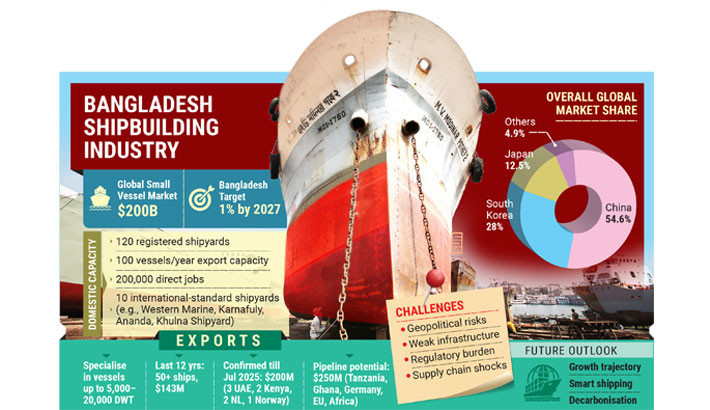Bangladesh aims to lead in green shipbuilding, pushes export growth
Exporters eye $1 billion in yearly ship exports by 2027 if systemic support is provided

Despite having a vast opportunity in global ship exports, Bangladesh has yet to capture even a single percent of the international market.
Experts blame the absence of long-term financing, lack of policy support, and poor infrastructure for holding back the sector’s growth.
At the same time, economists and industry insiders say Bangladesh holds significant potential to emerge as a leader in green shipbuilding – a move that could diversify exports beyond ready-made garments (RMG) and earn billions in foreign currency.
They estimate that securing just 1% of the $200 billion global market for small and special-purpose vessels (SSPVs) could bring in US$2 billion annually in exports, in addition to $500 million from local orders. By 2027, Bangladesh could realistically achieve $1 billion in yearly exports if systemic support is provided.
Economists point out that Bangladesh’s current export policy regime is heavily skewed toward RMG, with insufficient attention to non-RMG industries. To survive in the post-LDC (Least Developed Country) era, they argue, the government must prioritise diversification. Stakeholders recommend providing incentives for research and development (R&D) and technical innovation instead of relying on cash incentives, which may no longer be feasible after LDC graduation.
They further stress the need for consistent policy execution, export guarantees through specialised banking support, establishment of a shipbuilding development bank, and large-scale infrastructure upgrades.
Industry insiders argue that without such measures, Bangladesh risks missing out on a rare opportunity to establish itself in the global shipbuilding value chain.
Export orders and industry capacity
Western Marine Services Ltd Chairman Engineer Md Sakhawat Hossain told Daily Sun that Bangladesh currently has confirmed export orders worth $200 million up to July 2025.
“These include three ships for the UAE, two for Kenya, two for the Netherlands, and one for Norway,” he said. “Beyond that, there is pipeline potential worth $250 million, with new inquiries coming from Tanzania, Ghana, Germany, and other EU and African countries.”
Hossain noted that while Bangladesh had limited exports in recent years, international interest is rising again. To capitalise on this trend, he emphasised the urgent need for a dedicated financial institution:
“We need a separate bank for export guarantees. A Shipbuilding Development Bank, like those in China and Vietnam, would help us scale up exports,” he said.
Bangladeshi export-oriented shipyards mostly build cargo ships, offshore patrol vessels (OPVs), ferries, trawlers, tankers, and tugboats, specialising in vessels up to 5,000-20,000 deadweight tonnage (DWT). Current annual building capacity for exports is around 100 vessels.
Around two lakh people are directly employed in the shipbuilding industry. There are now 10 international-standard shipyards, and industry leaders believe the number can grow to 20 within two to three years.
Major players include Western Marine, Karnafuly, Ananda Shipyard, Khulna Shipyard, and Chittagong Dry Dock Limited. Together, they have exported more than 50 ships to destinations such as Germany, Finland, UAE, Kenya, Denmark, Ecuador, New Zealand, Gambia, India, Pakistan, and Norway.
Post-LDC challenges and global context
Dr Zaidi Sattar, chairman of the Policy Research Institute (PRI), cautioned that Bangladesh’s export target of $4 billion by 2026, as set out in the 2021 Shipbuilding Industry Development Policy, is “too ambitious.”
“Realistically, Bangladesh could reach $1 billion in exports by 2027 and $2 billion by 2030,” he said. “But to get there, logistics bottlenecks, customs barriers, and financing constraints must be resolved.”
Dr Sattar highlighted growing demand for eco-friendly vessels powered by LNG and clean technologies, stressing that Bangladesh has a labour cost advantage over competitors like China, India, and Vietnam.
He noted that globally, about 80% of trade goods by volume are carried by ships.
China dominates the industry, holding more than 50% of the global market with strong state support and competitive costs. Other countries with significant capacity include Brazil, Russia, Poland, and Romania, mostly serving domestic or niche markets.
“If each export-oriented Bangladeshi shipyard can raise exports to $100 million – which is achievable within two years – employment in the sector could double to 100,000,” he added.
Still, challenges remain. Production costs in Bangladesh are 15-20% higher due to weak backward linkages.
Moreover, external shocks such as COVID-19 and the Russia-Ukraine war have disrupted the supply chain. Despite these hurdles, the sector is showing signs of revival in FY2025.
Green shipbuilding: The next leap after RMG
Industries Adviser Adilur Rahman Khan said Bangladesh should seize the opportunity to lead in green shipbuilding, calling it the country’s “next big leap” after the garment sector.
“If the garment sector was our first great leap into global trade, green shipbuilding can be our next – delivering both economic growth and environmental stewardship,” he said.
Adilur stressed that the world is no longer satisfied with conventional ships, as sustainability has become a global standard. Countries that can design, build, and export low-emission, eco-friendly vessels will dominate the maritime economy of the future.
“Bangladesh can become a global hub for sustainable shipbuilding. We must act with vision and urgency to build facilities, attract investment, and establish international partnerships. Green ships carrying the ‘Made in Bangladesh’ label with pride is not a dream, it is achievable,” he said.
He also pledged that the government would coordinate with the Ministry of Shipping, Ministry of Environment, and other stakeholders to ensure regulatory clarity and create an investment-friendly environment for the green shipbuilding industry.
_____________________________
The reporter can be reached at [email protected]
Edited by: Anayetur Rahaman


